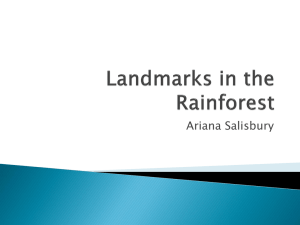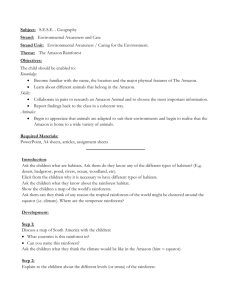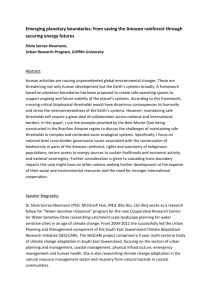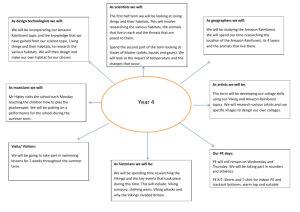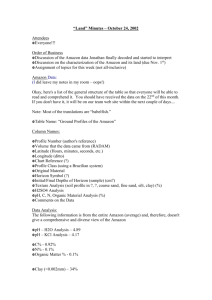The Amazon Basin
advertisement
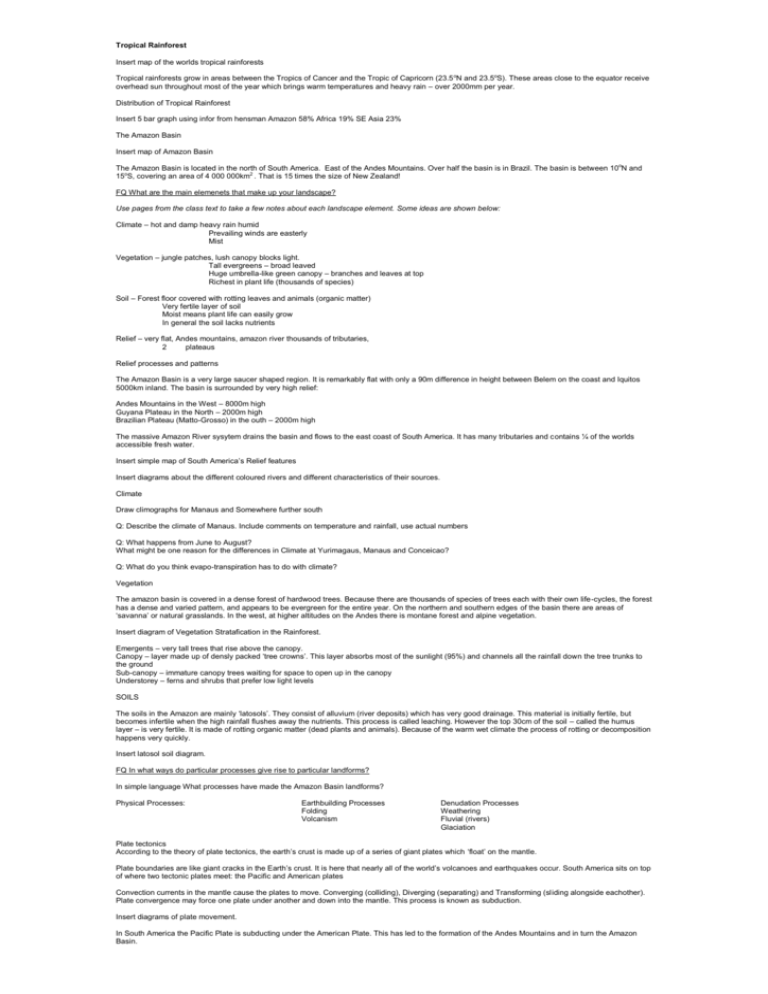
Tropical Rainforest Insert map of the worlds tropical rainforests Tropical rainforests grow in areas between the Tropics of Cancer and the Tropic of Capricorn (23.5 oN and 23.5oS). These areas close to the equator receive overhead sun throughout most of the year which brings warm temperatures and heavy rain – over 2000mm per year. Distribution of Tropical Rainforest Insert 5 bar graph using infor from hensman Amazon 58% Africa 19% SE Asia 23% The Amazon Basin Insert map of Amazon Basin The Amazon Basin is located in the north of South America. East of the Andes Mountains. Over half the basin is in Brazil. The basin is between 10oN and 15oS, covering an area of 4 000 000km2 . That is 15 times the size of New Zealand! FQ What are the main elemenets that make up your landscape? Use pages from the class text to take a few notes about each landscape element. Some ideas are shown below: Climate – hot and damp heavy rain humid Prevailing winds are easterly Mist Vegetation – jungle patches, lush canopy blocks light. Tall evergreens – broad leaved Huge umbrella-like green canopy – branches and leaves at top Richest in plant life (thousands of species) Soil – Forest floor covered with rotting leaves and animals (organic matter) Very fertile layer of soil Moist means plant life can easily grow In general the soil lacks nutrients Relief – very flat, Andes mountains, amazon river thousands of tributaries, 2 plateaus Relief processes and patterns The Amazon Basin is a very large saucer shaped region. It is remarkably flat with only a 90m difference in height between Belem on the coast and Iquitos 5000km inland. The basin is surrounded by very high relief: Andes Mountains in the West – 8000m high Guyana Plateau in the North – 2000m high Brazilian Plateau (Matto-Grosso) in the outh – 2000m high The massive Amazon River sysytem drains the basin and flows to the east coast of South America. It has many tributaries and contains ¼ of the worlds accessible fresh water. Insert simple map of South America’s Relief features Insert diagrams about the different coloured rivers and different characteristics of their sources. Climate Draw climographs for Manaus and Somewhere further south Q: Describe the climate of Manaus. Include comments on temperature and rainfall, use actual numbers Q: What happens from June to August? What might be one reason for the differences in Climate at Yurimagaus, Manaus and Conceicao? Q: What do you think evapo-transpiration has to do with climate? Vegetation The amazon basin is covered in a dense forest of hardwood trees. Because there are thousands of species of trees each with their own life-cycles, the forest has a dense and varied pattern, and appears to be evergreen for the entire year. On the northern and southern edges of the basin there are areas of ‘savanna’ or natural grasslands. In the west, at higher altitudes on the Andes there is montane forest and alpine vegetation. Insert diagram of Vegetation Stratafication in the Rainforest. Emergents – very tall trees that rise above the canopy. Canopy – layer made up of densly packed ‘tree crowns’. This layer absorbs most of the sunlight (95%) and channels all the rainfall down the tree trunks to the ground Sub-canopy – immature canopy trees waiting for space to open up in the canopy Understorey – ferns and shrubs that prefer low light levels SOILS The soils in the Amazon are mainly ‘latosols’. They consist of alluvium (river deposits) which has very good drainage. This material is initially fertile, but becomes infertile when the high rainfall flushes away the nutrients. This process is called leaching. However the top 30cm of the soil – called the humus layer – is very fertile. It is made of rotting organic matter (dead plants and animals). Because of the warm wet climate the process of rotting or decomposition happens very quickly. Insert latosol soil diagram. FQ In what ways do particular processes give rise to particular landforms? In simple language What processes have made the Amazon Basin landforms? Physical Processes: Earthbuilding Processes Folding Volcanism Denudation Processes Weathering Fluvial (rivers) Glaciation Plate tectonics According to the theory of plate tectonics, the earth’s crust is made up of a series of giant plates which ‘float’ on the mantle. Plate boundaries are like giant cracks in the Earth’s crust. It is here that nearly all of the world’s volcanoes and earthquakes occur. South America sits on top of where two tectonic plates meet: the Pacific and American plates Convection currents in the mantle cause the plates to move. Converging (colliding), Diverging (separating) and Transforming (sliding alongside eachother). Plate convergence may force one plate under another and down into the mantle. This process is known as subduction. Insert diagrams of plate movement. In South America the Pacific Plate is subducting under the American Plate. This has led to the formation of the Andes Mountains and in turn the Amazon Basin. Insert oblique sketch of Amazon Basin relief Insert 3 frame table with chunking that shows the formation of the Amazon Basin relief features. FQ In what ways do particular climates give way to particular landforms? Simple language How has the climate affected the Amazon Basin? The Amazon Basin’s warm and wet climate has influenced the relief vegetation and soil. In the mountains, the high rainfall and cool temperatures have caused glacial and fluvial erosion of the Andes and Plateau. In the Basin, the climate has resulted in prolific vegetation growth and rapid decomposition of soil. Climatic Processes There are three main climatic processes that have affected the Amazon Basin: 1. Convectional Rainfall 2. Movement of ITCZ 3. The Hydrological Cycle Concvectional Rainfall There are three ways that rainfall can be formed. The Amazon Basin experiences all three of these from time to time. But by far the most common type is convectional rainfall. Insert diagrams of rainfall types. The Amazon Basin receives a great deal of convectional rainfall because the sun is directly above it for much of the year. Another factor contributing to the high rainfall is evapo-transpiration from the rainforest. This is the release of moisture from plants, when they exchange carbon-dioxide for oxygen. It is estimated that around two-thirds of the rain that falls on the forest is returned to the atmosphere through evapo-transpiration. Movement of ITCZ The ITCZ is the Inter-Tropical Convergence Zone. It is a belt of low pressure around the earth that draws in wind from north and south of the equator. These winds are bent by the coriolis force (spinning of the earth). Insert diagram of ITCZ and trade winds In the Amazon Basin these trade winds bring moist air from over the Carribean Sea and Atlantic Ocean. This moist air rises when over the warm Amazon Basin results in more convectional rainfall. Insert map of South America showing movement of ITCZ and the direction of associated trade winds. Insert summary diagram showing three main reasons for Amazon’s convectional rainfall. This means that the ITCZ is situated over the Amazon Basin for most of the year, bringing high rainfall. In July when the ITCZ is most northerly, The Amazon experiences a ‘dry’ season of only around 50mm for the month. The Hydrological Cycle. The water cycle demonstrates that without the interference of people, the Amazon Basin’s rainfall could be sustained (continued indefinitely) Insert diagram of the water cycle. FQ Why do landscapes vary from place to place? Simple Why do different parts of the Amazon Basin have different characteristics? Students complete this essay by using the information covered so far and the text resources. FQ How do landscapes evolve through time? Obviously the Amazon Basin must have ‘changed’ when it was created (see previous notes on ‘The formation of the Amazon Basin’) This occurred around 150 million years ago. As a natural landscape – without human involvement – the Amazon Basin is stable and would maintain its present characteristics indefinitely. This is because both the nutrients and water are recycled and the sun is a constant source of energy. However, people DO interact with the landscape. People alter the landscape by altering one or more of the landscape elements? Which element do you think would have the most impact on the environment if people modifiedit? Why? Vegetation removal (deforestation) is the by far the biggest impact people have had on the Amazon Basin. Deforestation can cause permanent change to the Amazon landscape. Most people see this change as negative. Complete Effects of Deforestation diagram FQ In what way does human activity affect the natural landscape? Insert drawings to show that there are two groups of human affects. Traditional (sustainable): farming on varzea; shifting cultivation Modern (unsustainable): logging, ranching (cattle), large scale agriculture, roading and settlement, development projects. Traditional Agriculture Indigenous tribes have been living sustainably in the rainforest for thousands of years, and over the last few hundred years caboclas (early settlers of mixed european and african descent) have developed a lifestyle to survive in the rainforest environment. Both groups have developed forms of subsistence agriculture. This is when people grow food to meet their own needs rather than growing it to sell. These traditional uses of the land could be continued indefinitely without permanently affecting the land. The two traditional uses of the rainforest are carried out in two different parts of the rainforest: the varzea or river margins, and the Terra Firme or solid land. Varzea’s are the areas of land immediately beside rivers. They consist of alluvium that is deposited annually by flooding. The Terra Firme is the land away from the major rivers. They consist of the latosol soil type, and are not subject to flooding. Questions form text. 1. What are the advantages of the varzea? Most productive in terms of field crops Transport close by Fishing, gathering turtle eggs for food 2. What are the disadvantages? Flooding above 10m is normal River will occassionally change course and leave oxbow lakes and swampy areas Smell of rotting vegetation, trees, shrubs. Flies, bugs and mosquitos abound Bugs make it more difficult for growing food 3. What are the ways that people produce food here? Fishing, growing crops and trading. Insert diagrams of how farming is carried out on varzea Compared to the Terra Firme, the varzea’s are densly populated. This is mainly because annual flooding brings fresh alluvium to the soil. This allows people to live and farm in a location permanently. No matter how much food is taken through farming, the land remains fertile. Shifting Cultivation on the Terra Firme The basic technique is designed to raise the soil fertility for crops by burning a patch of forest. This releases all of the nutrients which are held in the trees and plants. As long as the fertility remains in the soil, the clearing will be farmed. However the growth of food crops, and weeds naturally absorbs nutrients from the soil and within 3-5 years the fertility will fall below the critical level for crops. The clearing will then be abandonned. This type of agricultural system is called ‘shifting agriculture’. Questions from text 1. Why is the vegetation burnt after being chopped down? 2. What are TWO reasons why the burn needs to be ‘hot’? 3. How large are the areas cleared under shifting cultivation? 4. What is another name for the clearing? 5. Why do you think there is no attempt at straight plots? 6. Why do the plants grow so quickly? 7. How could exposure to direct sunlight affect soils? 8. Which crop do you think is most significant to them? Explain? 9. In what ways do you think this sort of farming is a) efficient b) ineffecient? 10. What is the total time in years from cutting down swidden to abandonment? Insert flowchart diagram of shifting cultivation stages. Modern uses of the Rainforest. Highway construction and settlment Insert map of the amazon highway system 1. 2. 3. 4. 5. Loacate and colour the highways and two development projects Estimate the length of road from Recife to Peru Estimate the total length of road in the Amazon Basin Why do you think the roads were built? Brazil capital was moved from Rio De Janeiro to Brasilia in the 1960’s what does this tell you about the government’s intentions? The government of Brazil has built a major road network in the Amazon Basin. They saw this is a way of utilising the resources of the Amazon and promoting resettlement of people from the crowded cities and the drought-stricken north-east. The most important road is the Trans-Amazon Highway, which runs from Recife on the coast, to the border of Peru. Completed in 1975, it runs over 5500km. This is not a sealed and serviced highway, but a gravel road (occassionally sealed) cut through the forest. This has been important in opening the Amazon region for other uses of the rainforest. Land on each side of the Trans-Amazon Highway has been reserved for government-organised settlements. Landless families, mostly from north-east Brazil, are each given plots of land to clear and farm. The government also helps to build homes and provides credit to these ‘pioneers’ for the purchase of food, equipment and seeds. However the majority of the new settlers are not supported by the government. Most are landless peasants who have been attracted to the area by the prospect of free land. In the west, near Porto Velho, immigration has been on a large scale. Once the highway was opened, immigrants poured in from the south, at a rate of 700 000 per year. Most took land near the highway, felling and burning trees to make farmland for themselves. Ranching Ranching is a type of farming where cattle are raise don grasslands. This happens on a small scale (100 hectares) and a large scale (10 000 hectares). Small scale ranching occurs when families try to farm to meet their own food requirements and gain income for other household needs. Because farmers have had to borrow money for their land and equipment, they are reluctant to give up their land and move on like the tribes who practise shifting cultivation. Large scale ranching occurs when large corporations take advantage of ‘economies of scale’. They clear areas large enough for their farms and use heavy equipment to operate them. Companies, such as McDonald’s, practise large scale ranching in the Amazon because the land is very cheap. Problems with ranching Becasue the forest cover is removed over a large area, there is little organic matter returned to the soil. And the soil is exposed to heavy rain and intense sunlight. This quickly reduces the fertility and within three years only grass will grow. As more time passes even grass growth reduces, so farmers must graze cattle over a larger and larger area. Small scale farmers cannot afford to do this so they sell up to the large-scale ranchers. Question from text on Ranching 1. 2. 3. 4. 5. 6. 7. 8. How much each settlers ranch was to remain as rainforest? Why did the farmers not let the rainforest return as happens in shifting cultivation Why were crops like rice and corn unsuccessful for the settlers? Why is clearing the farm of all forest a ‘good idea’ from the farmers point of view? How many hectare are in one square kilometre? Which nutrient is quickly lost when the forest is cleared? What causes the soil to become compacted and hardened? Name two ways that ranching differs from shifting cultivation. Logging Although the rainforest contains many species of trees, only a few are sort after. The difficulty of moving equipment through the forest, removing trees once cut, and the massive distances involved, mean that much of the forest is uneconomic to log. Less than 5% of all timber cut down in the Amazon is used for timber. Most trees are cut down to clear land for farming and development projects. Building the Trans-Amazon Highway has improved accessibility and will likely allow more logging in the future. The Jari Project This was a project created by an American Businessman. He bought 16 000km2 (the size of the BOP) for around $1 billion. He planned to grow exotic forest (pine trees) in the rainforest environment. Create a diagram from Jari info. Inputs, Obstacles, - Outcomes, + Outcomes The Carajas Project Areas of forest have been cleared to expose rich mineral deposits of gold, copper and iron. An area of 90 million hectares has been cleared for Carajas. The project aims to mine the vast iron ore deposits and is essential to advancing Brazils plans for development. Extract some facts about carajas from text.

